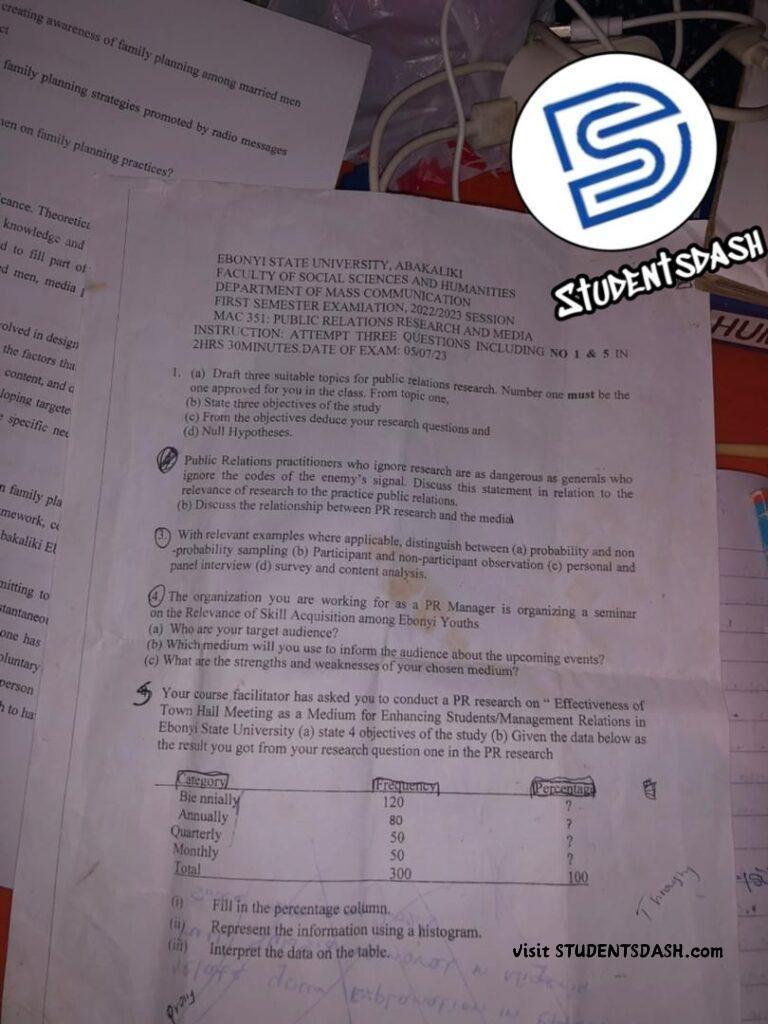
1. (a) Draft three suitable topics for public relations research. Number one must be the one approved for you in the class. From topic one,
Approved topic:
“The Role of Social Media in Improving Public Image of Government Agencies in Nigeria”
Other suitable topics:
2. “How Public Relations Can Help Fight Fake News in Nigerian Media”
3. “Effectiveness of Corporate Social Responsibility (CSR) in Building Brand Loyalty in Nigeria”
(b) Three objectives of the study:
- To find out how social media is being used by government agencies for public relations.
- To know the kind of content government agencies post that help improve their public image.
- To examine how people respond to and engage with the PR efforts of government agencies on social media.
(c) Research questions based on the objectives:
- How do government agencies in Nigeria use social media for public relations?
- What type of posts or content do they share to build a positive public image?
- How do Nigerians react or respond to these public relations efforts online?
(d) Null Hypotheses:
- Government agencies do not use social media effectively for public relations in Nigeria.
- The content posted by government agencies on social media does not have any effect on their public image.
- There is no significant relationship between how people respond on social media and the public image of government agencies.
2. Public Relations practitioners who ignore research are as dangerous as generals who go to war blind of the enemy’s signal. Discuss this statement in relation to the relevance of research to the practice of public relations.
This statement tells us that ignoring research in PR is like a general going to battle without knowing the enemy’s position; it is very dangerous and unwise. Public Relations is not only about sending messages out it is also about understanding the environment, the audience, and the overall impact of those messages. Research provides a solid base of facts and data that guides all PR activities.
Understanding the Audience:
Before launching any PR campaign, it is important to know who you are addressing. Research gives valuable information about the audience’s age, interests, habits, and needs. For instance, if a government agency wants to improve its public image using social media, research can show which social media platforms the majority of people use and what type of content they prefer. Without this research, the agency might use the wrong platform or post messages that do not connect with the audience.
Developing Effective Strategies:
Research helps PR practitioners to build strategies that are specific and effective. By studying past campaigns and current trends, PR professionals can learn what works well and what does not. For example, if research indicates that the audience reacts better to visual content over text, the strategy can shift to include more videos and images. This kind of informed planning minimizes risks and prevents wasted resources.
Measuring Impact and Improving Future Campaigns:
Research does not stop after the campaign is launched. It also includes monitoring and evaluation. This step is crucial because it tells the PR practitioner if the campaign achieved its goals or not. Surveys, focus groups, and data analytics offer clear insights into audience reactions and behavior changes. Without such feedback, PR professionals would be unaware if the message was misunderstood or if it failed to generate the desired response.
Avoiding Misinterpretations and Crisis Situations:
Ignoring research can lead to misinterpretations that may cause a crisis or backlash. For example, a company that launches a new product without understanding the cultural sensitivities of its audience might end up offending potential customers. Research helps to identify such pitfalls in advance, so that the message can be crafted carefully to avoid negative consequences.
Making Informed Decisions:
Much like generals who require updated intelligence to plan their attack, PR practitioners need current information to make informed decisions. Research provides the evidence and data that back up every decision made in a PR campaign from setting the objectives to choosing the medium of communication and timing the release of information. This process helps in building trust and credibility with the audience as they see consistent and well-informed communication.
Real-Life Examples:
Consider a situation where a public relations team ignores research and launches a campaign with messages that are too generic. The audience may feel that the campaign does not speak to their unique needs, leading to a lack of interest and engagement. In contrast, a campaign that used research to understand its audience might highlight specific issues of concern, use relatable language, and ultimately achieve a more positive response.
In conclusion, research in PR is like a navigation tool. Without it, practitioners are bound to make errors, misjudge the audience, and eventually face failure in their efforts to communicate effectively. Just as a general would never enter battle without proper intelligence on enemy positions, a PR practitioner should never ignore research as it is essential for planning, executing, and evaluating a successful public relations strategy.
3. Distinguish between the following with relevant examples where applicable.
(a) Probability Sampling vs. Non-Probability Sampling
Probability Sampling
- In probability sampling, every member of the population has a known and equal chance of being selected.
- This method is random and minimizes bias, making the findings more reliable and generalizable.
- Example: If you are surveying students at EBSU about their use of social media, you might use a simple random sampling where you randomly select names from the student list. This ensures each student has an equal chance of being chosen.
Non-Probability Sampling
- In non-probability sampling, not everyone in the population has a chance of being selected because the selection process is not random.
- This approach is easier and less expensive but can introduce bias because the sample might not represent the entire population.
- Example: You might survey only the students who pass by a specific location (convenience sampling) or select students based on their active presence on social media (purposive sampling). Here, the findings may not represent all EBSU students accurately.
(b) Participant Observation vs. Non-Participant Observation
Participant Observation
- In participant observation, the researcher actively joins in the activities of the group being studied while still observing.
- This method helps the researcher gain a deeper insight into the behaviors, attitudes, and social dynamics of the group.
- Example: A PR student might join a campus event to see how public relations messages are received by the audience and take part in discussions to understand the underlying sentiments.
Non-Participant Observation
- In non-participant observation, the researcher observes the group or situation without taking part.
- This method is used to get an unbiased perspective and minimize the researcher’s influence on the observed environment.
- Example: Instead of joining the event, the researcher sits in the audience and quietly observes how people interact, noting behaviors and reactions without any involvement.
(c) Personal Interview vs. Panel Interview
Personal Interview
- A personal interview is a one-on-one conversation between the interviewer and the interviewee.
- It can be structured (with a set list of questions) or unstructured (more like an open conversation).
- Example: Interviewing a single PR manager face-to-face about their experiences with media relations to gather in-depth insights.
Panel Interview
- In a panel interview, more than one interviewer is involved, and they may interview one candidate together or ask questions as a group.
- Alternatively, “panel interviews” can refer to a scenario where the same group of respondents is interviewed over a period of time to study changes in opinions or behavior (this is sometimes called a panel study).
- Example: A panel interview might involve a group of experts in public relations discussing the effectiveness of a new PR strategy, or a regular interview with the same group of students to track changes in their media consumption habits over a semester.
(d) Survey vs. Content Analysis
Survey
- A survey is a method of collecting data by asking people questions through questionnaires or interviews.
- It is used to gather information on opinions, behaviors, or characteristics from a sample that represents a larger population.
- Example: Distributing a questionnaire to EBSU students to collect their views on government public relations efforts on social media.
Content Analysis
- Content analysis involves examining and analyzing communications and documents (like news articles, social media posts, or advertisements) to identify patterns, themes, or biases.
- It is used to study the content of communication without interacting directly with the audience.
- Example: Analyzing the tone and messages in media articles about a government policy to understand how the information is presented to the public.
4. The organization you are working for as a PR Manager is organizing a seminar on the Relevance of Skill Acquisition among Ebonyi Youths
(a) Who are your target audience?
Our target audience includes Ebonyi youths between the ages of 18 to 35 years. This group covers a mix of secondary and tertiary students, young job seekers, aspiring entrepreneurs, and entry-level employees. They are the ones who can benefit most from the seminar by learning new skills and improving their career prospects. We might also include recent graduates and young professionals who are interested in developing practical skills for today’s competitive job market.
(b) Which medium will you use to inform the audience about the upcoming events?
For this seminar, I will use social media as the main medium to reach out to the target audience. Platforms like Facebook, WhatsApp, and Instagram are popular among youths in Ebonyi State. These platforms allow us to share engaging content, such as event details, attractive visuals, and reminders, and they provide the option for audience interaction through comments and messages.
(c) What are the strengths and weaknesses of your chosen medium?
Strengths:
- Wide Reach: Social media platforms have many users, making it easy to reach a large number of Ebonyi youths quickly.
- Cost-Effective: Sharing posts, creating event pages, and sending direct messages are low-cost or free, which is suitable for limited budgets.
- Interactivity: Social media allows for real-time engagement. Youths can ask questions, share the event with friends, and leave feedback.
- Visual Appeal: Using images, short videos, and infographics can catch the attention of the audience and make the event more appealing.
Weaknesses:
- Information Overload: Social media is crowded with many posts, which might make it difficult for our messages to stand out.
- Misinformation Risk: There is a possibility of misinterpretation or spread of incorrect details if the information is not clear or gets modified as it shares.
- Limited Internet Access: Not all targeted youths may have steady internet access or regularly check social media platforms, which could limit reach.
- Short Lifespan of Posts: Social media posts can get buried quickly under new content, meaning our event information might be quickly overlooked unless regularly updated.
Question 5
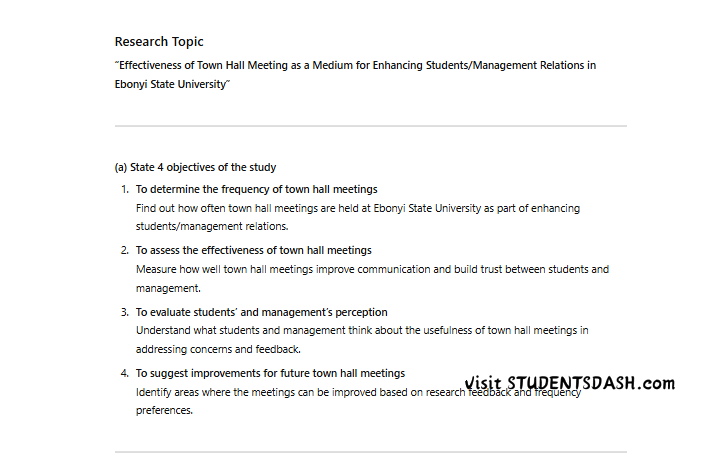
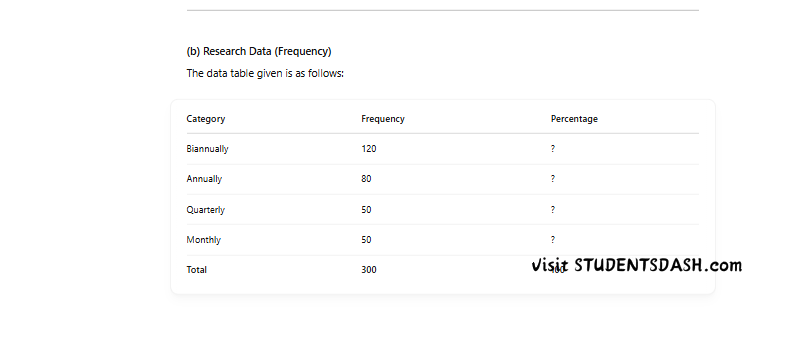
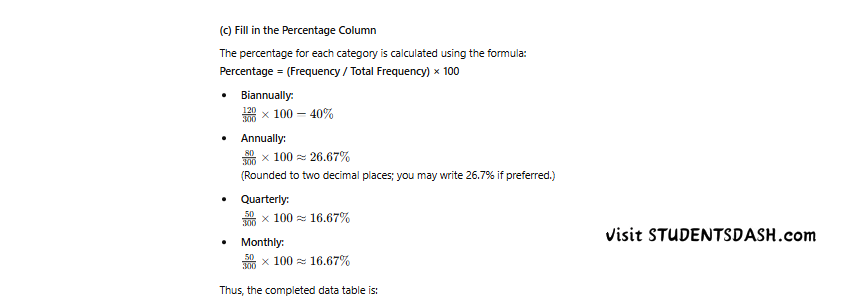
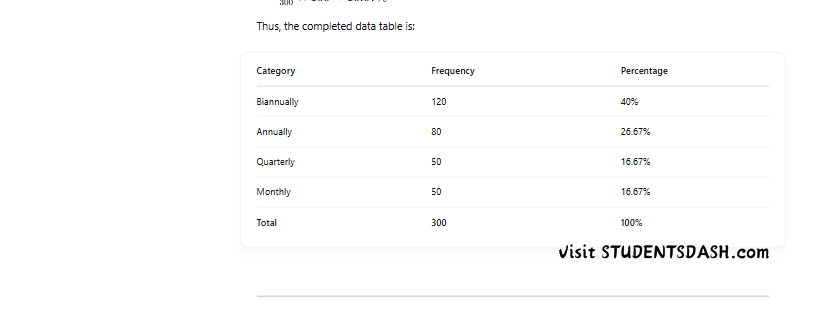
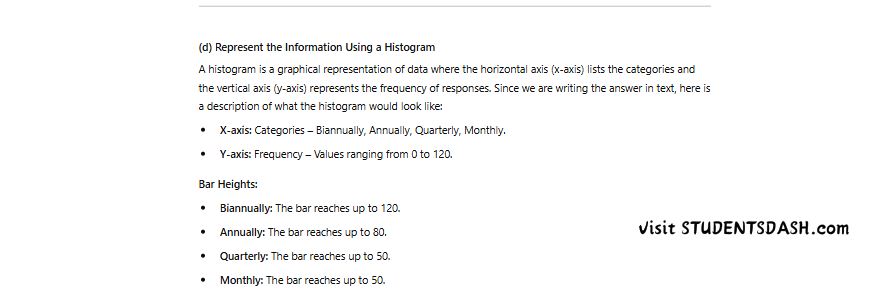

(e) Interpret the Data on the Table
The data shows the following:
- Majority Preference:
The highest frequency is for biannual meetings, with 120 responses (40%). This suggests that most respondents prefer or believe that town hall meetings should be held twice a year. This might mean that students and management feel biannual meetings are frequent enough to maintain good communication without being overwhelming. - Moderate Preference:
Annually comes next with about 26.67%. This indicates that a little more than a quarter of the respondents think that an annual meeting is sufficient. They might feel that yearly meetings are enough to touch base on important issues. - Lower Preference:
Both quarterly and monthly meetings have the lowest frequencies (16.67% each). This suggests that only a small portion of the respondents believe meetings should be held more frequently. It could imply concerns about the feasibility, cost, or information overload if meetings are too frequent.
Overall Interpretation:
The preference for biannual meetings shows a balance between having regular updates and avoiding meeting fatigue. While annual meetings might be too infrequent and quarterly or monthly meetings might be too demanding or redundant, holding the meeting twice a year seems to be seen as the most effective approach for enhancing students/management relations at Ebonyi State University.


Thank you so much studentsdash. This was really helpful.